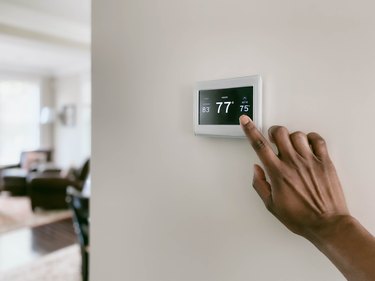
When comparing portable or window air conditioner options, you might come across self evaporating air conditioning units, but what does that mean? In addition to blowing cool air into a room, air conditioners also draw the moisture out of the room air and into the air conditioning unit. This moisture has to go somewhere. Self-evaporating air conditioners, which are growing in popularity, provide the added feature of getting rid of this moisture for you.
Tip
A self-evaporating air conditioner reuses the moisture it collects from the air to help with the cooling process. It eliminates the need to empty collected water from a tray or bucket.
Video of the Day
Air Conditioners and Humidity
All homes naturally have humidity in the air. Humidity is the moisture in the air, which is in the invisible form of water vapor. Even with normal human functions such as sweating and actions such as cooking and bathing, the interior relative humidity level goes up.
Video of the Day
Your air conditioner removes this moisture while they work to cool the air, which is why traditional window air conditioners need to be slightly sloped down towards the outside. This way, the moisture, which is converted into liquid form inside the unit, can drain to the outside and collect inside a container, which is often a bucket that needs to be emptied daily when the air conditioner is being used.
Self-Evaporating Air Conditioners
While you need to either manually empty an outside container of collected water or empty the unit's water collection tray with regular units, an air conditioner with self-evaporating technology reduces or eliminates this need. These units are also called no-drip units because the water does not drip from the rear of the unit.
Instead, the unit recycles approximately half of the condensed water and uses it to cool off the inner cooling coils, which allows the unit to run more efficiently. It then disperses, or evaporates, the remaining water into the outside air, along with the hot air that you can normally feel exiting the back of all portable air conditioners. Portable units do this by dispersing the water through the pipe that vents out your window. What a self-evaporating unit does is simply cut out any unnecessary water collecting inside the unit or in an outside container.
Self-Evaporating AC Maintenance
If the room in which the air conditioner is installed has high humidity, the condensation inside the unit might build up faster than the unit can recycle it and send it into the outside air. Under extreme conditions like this, you need to manually empty the water out of the small tray or tank located inside the self-evaporating unit. Read the owner's manual to learn when manual emptying is necessary and how to find the tray or tank on your specific air conditioning model.
Improving the Unit's Efficiency
You can take actions to help lower the indoor humidity yourself and stop the self-evaporating unit from being overloaded with compressed water that you must empty yourself. This can help save money on air conditioning by making it work more efficiently. Variations in the humidity in the air determine how fast the unit's water tray fills up. Invest in a hygrometer, which measures humidity and lets you know when the level is too high. Use vent fans in bathrooms and kitchens and also use a dehumidifier in rooms.